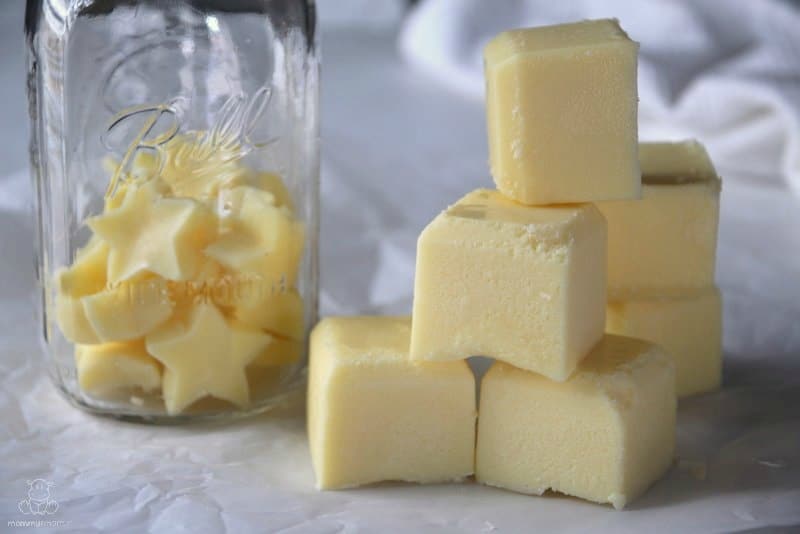
My list of kitchen essentials looks a *little* different from the many of the suggestions found in the 1887 White House Cookbook – which includes a fish kettle, coal shovel and ash bucket – but there are some things time just can’t improve on. One of those is the use of wholesome fats such as tallow, which can be used in cooking, candle making, skincare and more.
Although it may sound intimidating, rendering tallow is incredibly easy and takes just a few minutes of hands-on time. I’ll share my step-by-step guide later on in the post, but first let’s dive into some of the most frequently asked questions about this healthy traditional fat.
What is tallow?
Tallow is rendered beef or lamb fat. Before unhealthy vegetable oils took over our kitchens, tallow was often used for frying because it’s stable at high temperatures. It also contains several components that are thought to be beneficial, including:
- Conjugated linoelic acid (CLA) – Studies suggest that CLA increase fat metabolism, help regulate the immune system, and promote heart health. (1) (2)
- Vitamin K2 – This is the elusive “X Factor” studied by Weston A. Price, DDS, who authored Nutrition and Physical Degeneration. It supports bone health, heart health and optimal brain function. (3)
- Omega 3 fatty acids – Our bodies can’t make omega 6 or omega 3 fatty acids, yet they are essential for health. We have to obtain them from food in a healthy ratio for optimal health. Most of us consume too much omega 6 and not enough omega 3. Beef tallow contains a ratio of omega 6:3 that considered more balanced and beneficial. (4)
Another common question is how tallow is different from lard. The answer is that lard is rendered in the exact same way as tallow, but it’s derived from pork and has a different nutrient profile. I’ve covered those details in this post on rendering lard.
4 Uses For Beef Tallow
- Cooking, frying, and baking – Use as you would coconut oil or butter
- Tallow soap or shampoo bar soap
- Nourishing skin (tallow has lots of benefits for skin and it’s super easy to make into whipped tallow balm)
- Making candles – Some people have used tallow in place of coconut oil when making beeswax candles with good results. I’m not a fan of the way tallow smells while burning so I personally wouldn’t use it unless I was making candles to for emergencies such as power outages.
Sourcing Beef Tallow
Before you run out to your local butcher shop to buy what they have on hand, consider this: An analysis found that tallow obtained from grass-fed beef had four times more omega 3 fatty acids than grain fed. (5)
Also, the CLA content of milk from grass-fed cows is as much as five times higher than when cows are fed 50% silage and 50% grain. Although we’re talking today about tallow and not milk, it’s likely that the CLA content of tallow is higher when derived from grass-fed beef fat. (6)
Another thing to consider is that antibiotics and other unwanted substances given to conventionally-raised cows are likely to be stored in their fat. For this reason, I recommend obtaining beef suet from pastured sources like this one.
How To Render Tallow (Step-By-Step Guide)
What you’ll need:
- grass-fed beef suet (find it here)
- slow cooker (this is what I used)
- food processor
- sharp knife
- cutting board
- Jar
- Silicone ice cube molds – optional (I used these and these)
Chill the suet in the fridge to make it easier to work with, then cut it into small chunks. Trim away any meat or gristle you see as you cut, but don’t stress about getting every little piece. What you miss can be strained out at the end, so just get as much as you can.
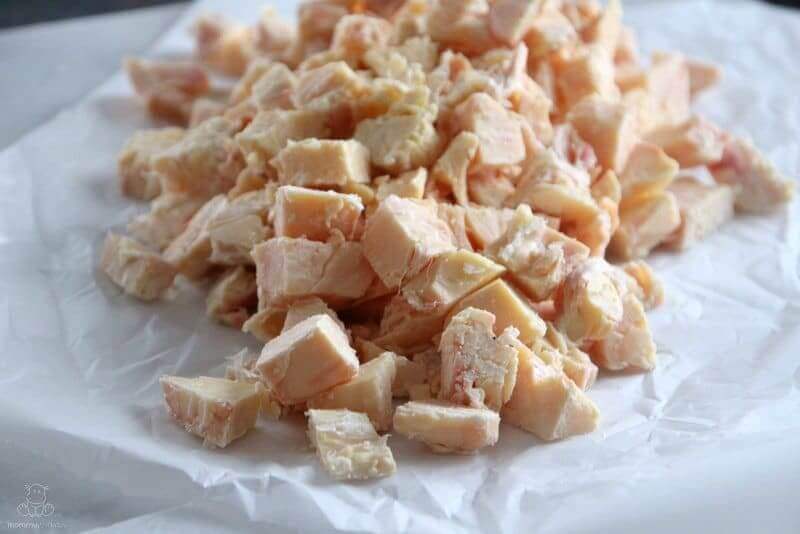
Place the chunks in a food processor and grind until they the suet looks something like this:
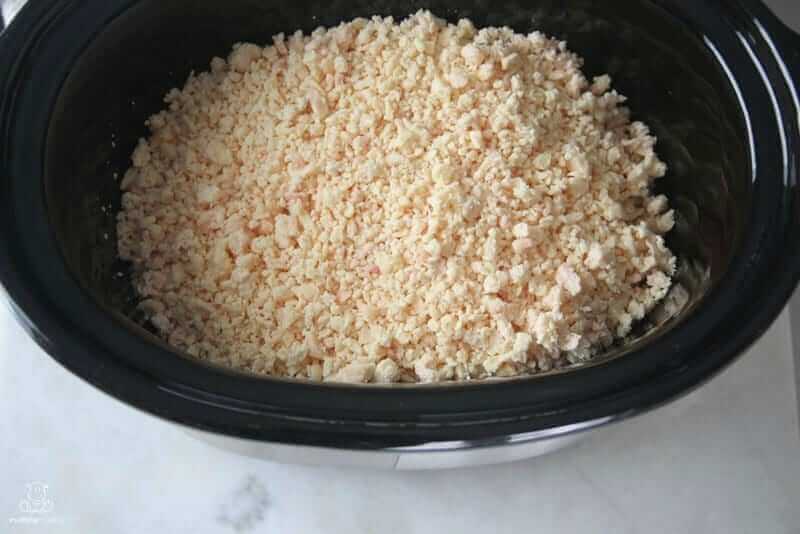
Add the suet to a slow cooker as pictured above and set the temperature to low so that the fat begins to melt. I usually place my slow cooker on the back porch for this step because although I don’t mind moderate amounts of tallow while cooking, rendering a large amount creates a strong scent in my kitchen that I’m not a fan of.
Your total cook time will depend on how much suet you used, but you’ll know it’s ready when the little pieces of gristle you couldn’t trim away are golden brown and floating at the top of the melted fat. When I used about 2 pounds my cook time was about 7 hours.
Strain the tallow by pouring everything through a colander that has been lined with a cheesecloth.

At this point you can pour the tallow into a jar for storage, but the problem with that is if you store your tallow in the fridge or freezer to extend its shelf life, you’ll find that the tallow becomes very hard and difficult to remove from the jar.
For that reason, I like to pour my tallow into silicone ice cube molds and then place them in the fridge for about an hour to harden. Once they are firm, I pop them out of the molds and place them in a jar. Each cube is just about what I need for frying something in a pan, which makes it super easy to grab what I need.
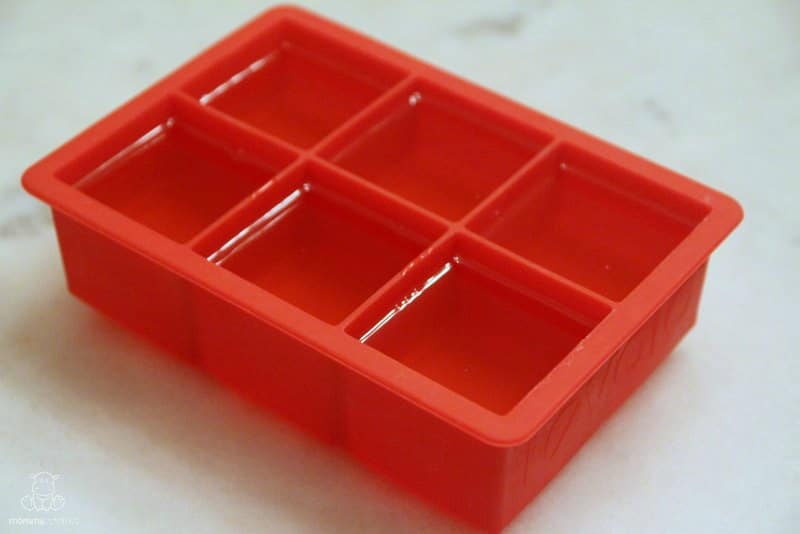
I recommend storing tallow at room temperature for about a month, or in the fridge for several months. It can also be stored in the freezer for over a year.
Source for this article:
1. Blankson, H et. al. (2000) Conjugated linoleic acid reduces body fat mass in overweight and obese humans. Retrieved from https://www.ncbi.nlm.nih.gov/pubmed/11110851
2. Sailas, Benjamin et. al. (2009) Conjugated linoleic acids as functional food: an insight into their health benefits. Retrieved from https://www.ncbi.nlm.nih.gov/pmc/articles/PMC2754987/
3. Rheaume-Bleue, Kate. (2013) Vitamin K2 and the Calcium Paradox
4. Daley, Cynthia et. al. (2010) A review of fatty acid profiles and antioxidant content in grass-fed and grain-fed beef. Retrieved from https://www.ncbi.nlm.nih.gov/pmc/articles/PMC2846864/
5. Masterjohn, Christopher. (2014) Fatty Acid Analysis of Grass-fed and Grain-fed Beef Tallow. Retrieved from https://www.westonaprice.org/health-topics/know-your-fats/fatty-acid-analysis-of-grass-fed-and-grain-fed-beef-tallow/
6. Harris, Lynette. CLA: The Modern Food Chains Weak Link. Retrieved from https://extension.usu.edu/dairy/files/cla

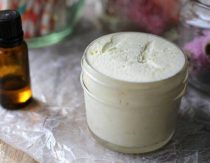
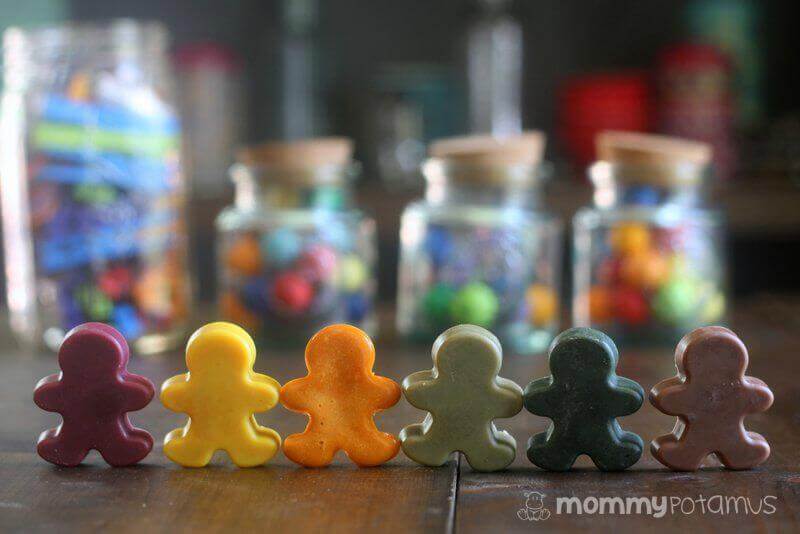


This looks pretty easy! I hope to get some suet soon. Is there a use for the leftover connective tissue that doesn’t melt?
It really is! You can use the leftovers to make cracklings in the same way that you’d make them after rendering lard. Here are the instructions: https://mommypotamus.com/render-lard-crock-pot/
Honestly, I don’t, though. Not a fan of the flavor 🙂
I am wondering can I use deer fat for tallow,.
Deer fat is not pleasant to eat, and I don’t usually find much on any of mine in any case.
Trust me on this one.
Deer tallow does make good candles and soap. I got about 6 quarts from my harvests & my grandson’s this season.
First I must say that I discovered your site after watching the Wellness Summit and I’ve pretty much been obsessed ever since! It’s absolutely amazing and I cannot thank you enough for sharing your wealth of information! Now to the point…after reading one of your posts about tallow last week, I went on a hunt for grass fed render tallow and beef suet. I came up empty handed. I went to the local farmers market and the butchers there couldn’t promise me the tallow/suet would be grass fed. Do you have any tips or ways you can suggest to find tallow from a local or online source? Honestly, I would prefer to find it locally but any help is appreciated! Have a great day!
Brianne, I am so glad you found this community! Katie is such an inspiration and I’m so honored that she invited me to speak.
What a bummer that you weren’t able to find any. If you’ve already done a search for local ranches via http://www.eatwild.com and http://www.localharvest.org and nothing turned up, your best bet might be to order some pre-rendered grass-fed tallow online. Here’s where I would shop if I didn’t have local access: https://mommypotamus.com/tallow
Thank you SO SO SO much for those websites! They are exactly what I was looking for. I have plenty of options around me, I just wasn’t look in the right place apparently! Looking forward to beginning my whole foods and body care journey thanks to you!
I was able to find some by contacting my local Weston A. Price chapter 🙂 http://www.westonaprice.org/get-involved/find-local-chapter/
This is the first time I have heard of beef suet and I’m now clued into tallow which I had just a vague idea of what it was. Your posts fill in some gaping gaps I have in my ongoing ‘food education.’ Thanks, Mommypotamus :).
I’m a little foggy on the difference between tallow and suet. The description from my local source says:
While tallow is external fat, suet is harvested from around the kidneys. It has a characteristic chalky colour and is more firm than tallow.
Both, it said need to be rendered. Would both work the same for this recipe and have the same benefits?
Suet is the fat from around the kidneys.
Tallow is rendered suet used for other applications such as soap making, cremes, and cooking.
One time, I was rendering tallow over the stove top. I was impatient so I turned the heat up to high (trying to get it to come to a simmer before I turned it to low — I was rendering a couple gallons, mind you). I didn’t realize that it was time to turn it down and it exploded all over the kitchen. Such a mess! Good thing no was was in the kitchen or someone could have gotten scalded! I cleaned it up the best I could… but alas, the next time I went to cook the tallow, that had sneaked under the range, caught fire. I was absolutely embarrassed to explain to the firemen was tallow was, what I was doing with it, and why I has so darn much of it!
A couple tips, don’t ever turn it up higher than boiling point or it will explode. Also, if a fire starts, throw baking soda on it — not water. (I knew not to throw water on it, but was pleasantly surprised to see how quickly baking soda staunch the fire.)
I’ve got way to much going on right now to run out to the kitchen to try this – BUT I will definitely be saving this post for future use. About how long does it take?
Hi! I tried rendering the suet I got from our grassfed beef we got a couple weeks ago. Worked like a charm, but there is some weird brothy stuff in the bottom. I strained it twice and left most of the broth in the bowl the second time so it didn’t get into the final bowl, but there are still a few drops. Just wondering if I did something wrong? I actually had 2 different sources for my suet, one of them was white with no red bits, and the other was a bit meatier. Maybe that’s where the broth came from? And does it even matter that it’s there? Thank you!!
So I make beef stock about once a week and after my stock is done I strain it and put it into jars and each jar gets a lovely thick layer of fat that hardens on the top… Is that tallow? Can I be harvesting that for the same uses as tallow? I’ve been using it here and there for cooking but I get too much of it sometimes and toss it, but if I knew it was tallow I would save it and make things from it like soap or candles or skin cream. I’ve been wondering this for years so I’d love any insights you could provide mommypotamus 🙂
I wondered the same thing. I have a jar of beef fat from when I roasted marrow bones and poured the liquid fat from the bones into a mason jar.
Yes, me too! I roast my marrow bones before putting them into the crockpot to make broth. Roasting melts off a ton of fat that I have been saving in mason jars to cook with. I’m assuming this is ok to cook with? Advise!
Hi! Rendering your own tallow is great, but the best fat for this is “Leaf Fat” which comes from the kidney area. Ask for it specifically, as it has less cartilage to deal with, and more of the good stuff! I used to work in a meat processing facility.
Hello, great post. Have you tried wet rendering? If so , is the smell any better (or less intense)?
Hi Heather
I can tell you’re a fan of tallow as many of your DIY Beauty recipes include it. What is your alternative for vegetarians?
Thanks
Amanda
Love your site! Thanks so much for all the great info 🙂
When I make bone broth from beef bones, once cooled, the fat at the top is hard and off-white…is this beef tallow?
HI Tracy, yes it is, but it is not as shelf stable as tallow that is traditionally rendered. The reason is that the fat skimmed off of broth typically has water mixed in, which decreases it’s shelf life.
Thank you so much – I always felt bad for throwing it out after making my broth. I will keep it in the fridge and figure out how to use it 🙂
Sure thing. You can fry with it or use it to replace butter in baked goods.
I make a lot of beef bone broth. The fat from this is rendered???Can I use this on my face and body will it go rancid? How can I keep it from going bad?
Hi Mary, yes it is rendered but it contains a lot of moisture and will go bad easily. Fat that has been rendered apart from water is much more shelf stable.
HI Mommypotomus!
Love your “Call Sign” (which is Navy lingo for ‘nickname’)
I’m also a New Follower and am excited about learning all your bountiful information; Thank you so much for sharing your knowledge with us!
Such a timely article! My husband hunts and harvested a bear last week! I rendered some of the cleanest, scentless fat I’ve ever seen (backwoods Montana bear that had feasted on wild edibles. No dumpsters for him! )! I planned to use it just for leather conditioner and maybe lamp oil but I tried it on my face and it is amazing! So smooth and silky! The lard is almost odorless -just a faint sweet smell – and I added some essential oils to it for further skin pampering. Thank you for your article that encouraged me to take advantage of an amazing natural resource! I have not worked up the courage to tell anyone except my husband that I am smearing bear grease on my face yet 🙂 He gets quite a chickle out of it 🙂 My 2 toddlers sure are growing up with a different “normal” than most children, and I love it! Thank you for all you do!
WHY have I not be rendering my suet this way?! The strainer in the pot is pure genius – I always do my crockpot and the straining part is super greasy/messy and I never look forward to it. I am so doing it this way next time! Great post 🙂
My husband and I are avid deer hunters and we process our own deer. I wonder if I can do this with venison and if the fat should only be taken from certain parts of the animal or just anywhere I find it.
Can I use pork lard for my skin?
Yes, you can. It doesn’t absorb as well, but it can be used.
OK…encouraged by my daughter, I made tallow from beef suet. But, alas, during the first attempt it was turned up too high on the end and it burned a bit. Can it still be used for skin creme? It smells slightly over done. Hate to waist it after waiting 5 hours for it to melt. I did strain it twice. Does it lose healthy properties if it is burned?
Thanks for your advise.
-N
Lovin your website! Just wondering what do you call the fat you get from making bone broth…I get loads of fat and not sure what it can be used for. Is it tallow/suet?
Yes, it’s tallow. However it’s tallow mixed with water from the broth, so it will go bad very quickly if left out. I leave some in the broth and then use the rest to fry foods within a week of making broth.
genius method. everyone was telling me how your kitchen gets to stink horribly when rendering tallow, and it doesn’t!
question on percentages, how much fat does one get form a given amount of fat? I know it depends, but am looking for an average. I am rendering 4 kg of fat, what shall I expect? 1 kg? 2? thanks!
Expect to get almost one pint of rendered fat from every pound of clean, unrendered organ fat. Yields may be lower with trimmings and fat back.
Thanks so much for this tallow guide. I love trying new things. But sometimes its confusing when reading some recipes or instructions and I have more questions than answers. I’ve come across a few of your recipes and you make it seem so easy. One of your soap recipes is what finally gave me the push I needed to start making my own soap. I can’t wait! Again thanks ☺
Everywhere I read it says to render it with LOW heat. My husband took it upon himself to render (a lot in a big pot) and had it boiling pretty good (with some water – not sure how much) and only took a couple hours (or less) to do. Granted he may not have gotten all of it melted (figured what he got (which was about 3-4 quarts) was enough). I didn’t see any evidence of it having burned. Is there any reason not to do it this way? (Somewhere else I read “When rendering any fat you need to keep your temperatures as low as possible, if you do not you can polymerize the fat across the double bonds that are in the middle of the fatty acids. Polymerized fat can still be used for candles and such but will not be useful in making soaps or have the same nutritional benefits”
We weren’t even thinking of using this for food – I had plans for candles, lotion and soap. Oh & this is elk tallow in case that makes any diff.
Thnx!
Thanks for the recipe, being lazy I modified it by lining the sieve with kitchen paper before putting the suit in, the resulting tallow was filtered as it melted, also safer as not poring hot fat. Worked a treat. Thanks
Mark
Found your site when looking for something a little different. Noticed some posts about left over fat that is skimmed off broth. As you say it is less shelf stable than your tallow but people are wanting to use it- could be possible to use as rush lights? Just a thought.
Thank you – this is wonderful! We are on a mission to market our cattle from ‘nose-to-tail’, and I was looking for a simple way to recommend rendering suet into tallow. This is it! Thanks again.
Hi Heather. Typical man that I am I started the rendering before checking the net for some instruction. (ie: instructions? I’m a guy, why would I need them?) That being said (confessed) I have some beef fat in a large pot on the stove at very low temp as I type. I didn’t cut the fat into small pieces but I guess I’ll see where it goes from here. I recall many years back as a trucker I would on occasion pull over at some side of the road “chip truck” for a snack. One of those had the most amazing tasting fries I had ever tasted. I once asked the lady how her fries were so good and tasted so different, her reply: Beef Fat! Many years on now I just stopped in to see the butcher at the small, local grocery store and asked if he had any beef fat. Bingo! The man wrapped a few pounds and told me they normally just get rid of it to a local rendering company. My cost? Zero! The man seemed happy to get rid of it and suggested that if I need more to drop in and let him know. Now, I don’t think there is a better price than free and if there is do tell me. I’m smiling because I just got for free what I’d guess most folks pay for by way of deodorized lard or worse, processed vegetable oil, most of which I suspect will kill me sooner than later. Thanks for taking the time to post your thoughts on rendering animal fat. BTW, those fries I mentioned, not only did they taste unbelievably great but they also had the most amazing golden colour without being burnt or dried out. (p.s.) Fish and chips tonight I think.
I have tallow left over from making bone broth. Of course, I added vinegar, onion, carrot & celery. I don’t know what to do with the leftover tallow. Would this be suitable for a balm?
Can you use bacon grease fat to make lye soap. I remember my mom making it yrs ago and using for laundry soap. Guess would need to melt, strain and go from there????
Can you use bacon grease fat to make lye soap. I remember my mom making it yrs ago and using for laundry soap. Guess would need to melt, strain and go from there????
I’ve been rendering for approx. 1 week now… after years.
I managed to get approx. 11kg of beef fat from my butcher
threw about 3.5kg into a large pressure cooker with 1L of water.
Let it cook on medium for approx. 1 hour
Let cool and then pour out contents into a sieve on top of a large pot.
Let it set in my garage (currently -21C)
Remove tallow (gorgeous white!)
Wash in a water bath for 10min and strain out into another pot.
Set in garage overnight- remove and rinse in cold water, dry, weigh and start filling my bucket.
So far, I have rendered 4.9kg (10.8lb) and I’m on the last batch- pressuring for the 3rd time as i did each batch. It’s never ending!!
I was trying to find out how to deodorize it somehow (baking soda bath) and found this.
thank you!
That’s neat, pressure cooking the beef fat for faster rendering. Makes me want to get a pressure cooker. I had great luck finding beef fat on craigslist believe it or not. The person had freezer full of grass-fed beef and pastured pork. Was giving it away for free. Got 20lbs of each. The rendering process takes so long in the oven or crockpot that I haven’t done it all yet. Still, I have jarred 1.5 gallons of tallow and I used my vacuum sealer. suck the air out of the jars and seal them. Supposedly it will keep that way at room temp or better yet garage temps.
I made a whipped tallow moisturizer from Tallow + Avocado oil + Vit E + Beeswax + Essential oils of rose, lemon, and a little rose geranium. The smell is pretty faint but my dog can still smell it lol! Should I just search “baking soda bath” to learn how to deodorize the tallow or do you have a link you could reply with? I would like to make it less smelly. Thanks in advance.
Thank for the advice. Other sources also advised pasture raised beef was extremely important. I plan to use it with lard and beeswax as leather conditioner.
Thank you so much for this! I have sourced my beef fat and am rendering right now – only, I still have a generous 4 pounds of fat left. What else can I use it for? I also make your deodorant – could I replace the coconut oil with the tallow?
Can rendered pork fat be used in the same manner? I have some in the freezer I need to render.
does it matter which type of beef fat you use for tallow? say back fat or kidney fat (suet)?
This looks pretty easy! I hope to get some suet soon.
This is my first time rendering tallow, and I plan to use some for soaps and some for candles. I have a question about naturally scenting the tallow for candles. Could you during the above rendering process add things like orange peel, whole cloves, etc. and strain all at the end? Or would you render the tallow first, then after straining infuse with the orange peels etc. at that point? Would this be better than adding essential oils after pouring into candle jars and allowing to cool to 80 degrees then gently stir? Thank you!
I haven’t tried it but I think it could work. If you do please let us know how it turns out!
Do you have any recommendation in cleaning the cheesecloth after you are done? I was really hoping to re-use mine. Thanks!
Recipe: How To Render Tallow?
I made this recipe just the other day. I was able to get my tallow from a meat market. Very inexpensive. Three pounds was just a couple of dollars. Will be getting more. I purchased some tallow from Amazon about a month ago. What the cost for a pint was I could have bought 10 lbs. Love the flavor rendered tallow gives fried foods. We very seldom fry anything. I followed your instructions exactly.
Came out perfect. Your instructions suggested not to render the tallow in the house. I am glad I didn’t. The odder was a bit strong. I rendered the tallow in the barn. I am going to use most of the rendered tallow to make Pemmican.
This recipe is a keeper.
Thanks so much for the information. My neighbor burns his. I recently started making my own herbal remedies and products so this is helpful. I asked him if I can have it. We generally barter items or I give him canned goods. I’m new to your blogs.
With 2 lbs of suet roughly how much tallow will come from this?
It depends on how much gristle is present. I don’t think I’ve ever measured so I can’t give a ballpark estimate, unfortunately.
I wonder how you clean all the devices and clothes. I just made my first batch and I am scared to clean it in the sink and washing machine. I don´t want to cloak my pipes. Any recommendations?
Thank you
Sincerly Bettina
So I made the tallow the traditional way and I plan to make a whipped balm with it. However, my tallow still has a beefy smell to it, even after adding essential oils. Did I do something wrong or is that normal?
It’s pretty normal. There is a “wet method” for rendering tallow in a mixture of water and salt that can make it virtually odorless, but I am not bothered by a faint odor so I usually use this method. 🙂